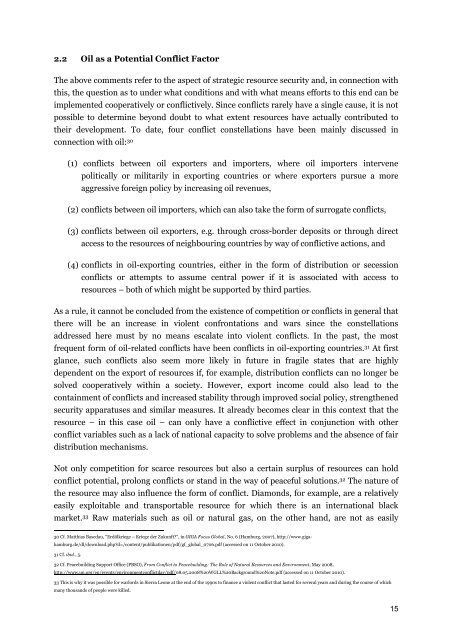PEAK OIL
PEAK OIL
PEAK OIL
You also want an ePaper? Increase the reach of your titles
YUMPU automatically turns print PDFs into web optimized ePapers that Google loves.
2.2 Oil as a Potential Conflict Factor<br />
The above comments refer to the aspect of strategic resource security and, in connection with<br />
this, the question as to under what conditions and with what means efforts to this end can be<br />
implemented cooperatively or conflictively. Since conflicts rarely have a single cause, it is not<br />
possible to determine beyond doubt to what extent resources have actually contributed to<br />
their development. To date, four conflict constellations have been mainly discussed in<br />
connection with oil: 30<br />
(1) conflicts between oil exporters and importers, where oil importers intervene<br />
politically or militarily in exporting countries or where exporters pursue a more<br />
aggressive foreign policy by increasing oil revenues,<br />
(2) conflicts between oil importers, which can also take the form of surrogate conflicts,<br />
(3) conflicts between oil exporters, e.g. through cross-border deposits or through direct<br />
access to the resources of neighbouring countries by way of conflictive actions, and<br />
(4) conflicts in oil-exporting countries, either in the form of distribution or secession<br />
conflicts or attempts to assume central power if it is associated with access to<br />
resources – both of which might be supported by third parties.<br />
As a rule, it cannot be concluded from the existence of competition or conflicts in general that<br />
there will be an increase in violent confrontations and wars since the constellations<br />
addressed here must by no means escalate into violent conflicts. In the past, the most<br />
frequent form of oil-related conflicts have been conflicts in oil-exporting countries. 31 At first<br />
glance, such conflicts also seem more likely in future in fragile states that are highly<br />
dependent on the export of resources if, for example, distribution conflicts can no longer be<br />
solved cooperatively within a society. However, export income could also lead to the<br />
containment of conflicts and increased stability through improved social policy, strengthened<br />
security apparatuses and similar measures. It already becomes clear in this context that the<br />
resource – in this case oil – can only have a conflictive effect in conjunction with other<br />
conflict variables such as a lack of national capacity to solve problems and the absence of fair<br />
distribution mechanisms.<br />
Not only competition for scarce resources but also a certain surplus of resources can hold<br />
conflict potential, prolong conflicts or stand in the way of peaceful solutions. 32 The nature of<br />
the resource may also influence the form of conflict. Diamonds, for example, are a relatively<br />
easily exploitable and transportable resource for which there is an international black<br />
market. 33 Raw materials such as oil or natural gas, on the other hand, are not as easily<br />
30 Cf. Matthias Basedau, "Erdölkriege – Kriege der Zukunft?", in GIGA Focus Global, No. 6 (Hamburg, 2007), http://www.gigahamburg.de/dl/download.php?d=/content/publikationen/pdf/gf_global_0706.pdf<br />
(accessed on 11 October 2010).<br />
31 Cf. ibid., 5.<br />
32 Cf. Peacebuilding Support Office (PBSO), From Conflict to Peacebuilding: The Role of Natural Resources and Environment, May 2008,<br />
http://www.un.org/en/events/environmentconflictday/pdf/08.05.2008%20WGLL%20Background%20Note.pdf (accessed on 11 October 2010).<br />
33 This is why it was possible for warlords in Sierra Leone at the end of the 1990s to finance a violent conflict that lasted for several years and during the course of which<br />
many thousands of people were killed.<br />
15


